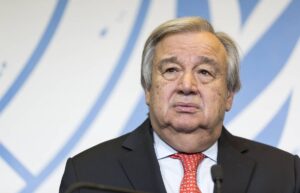
Ukraine’s losses from destruction due to a full-scale war against Russia amount to at least $100 billion, the war has led to a complete shutdown of half of Ukrainian enterprises, Oleh Ustenko, adviser to the President of Ukraine, said.
As of March 7, the International Monetary Fund (IMF) predicted a fall in Ukraine’s GDP in 2022 as a result of Russia’s armed aggression, provided that it ends as soon as possible, by 10% and inflation rises to 20%.
The financial gap of Ukraine in 2022 is estimated from $4.8 billion according to the balance of payments method to $7.4 billion according to the fiscal balance method, such estimates were given by the International Monetary Fund (IMF) as of March 7 in materials for emergency financing for Ukraine in the amount of $1.4 billion posted on its website.
The International Monetary Fund (IMF) calculation methodology, which takes into account such military conflicts, estimates the fall in GDP due to Russia’s full-scale war against Ukraine at 35% in 2022, Alternate Executive Director for Ukraine at the IMF Vladislav Rashkovan has said.
The Ukrainian economy is suffering greatly from the war unleashed by Russia, the decline in its GDP could be a third of what it was before the war, International Monetary Fund (IMF) Managing Director Kristalina Georgieva said in a Foreign Policy Live discussion.
The Ministry of Economy estimates the amount of losses from the Russian invasion of Ukraine at $564.9 billion, First Deputy Prime Minister and Economy Minister Yulia Svyrydenko has said.
The fall in Ukraine’s gross domestic product (GDP) as a result of full-scale Russian military aggression is currently estimated at 35% or more, Prime Minister Denys Shmyhal said in an interview with Interfax-Ukraine.
Ukraine’s losses from Russia’s full-scale military aggression, taking into account both the destruction already inflicted on the infrastructure and economy, and future losses in subsequent years, exceed $1 trillion, Prime Minister Denys Shmyhal said.
The state budget in January-February 2022 had a surplus in the amount of UAH 24 billion, including a surplus of UAH 13.1 billion for the general fund, with a planned deficit of the general fund for this period of UAH 66.2 billion, the Ministry of Finance reported on its website.
The deficit of Ukraine’s foreign trade balance decreased by only 0.2% in 2021 compared to 2020, from $0.678 billion to $0.676 billion. According to it, over the past year, exports of goods and services increased by 34.3%, to $79.724 billion, while imports – by 33.9%, to $80.401 billion.
Ukrainian transport companies carried almost 2.657 billion passengers in 2021, which is 3.4% more than in 2020.
The transport enterprises of Ukraine (excluding the territory of the Autonomous Republic of Crimea and Sevastopol, as well as part of the JFO zone) in 2021 increased transportation of goods by 3.3% compared to 2020 – up to 619.9 million tonnes, the State Statistics Service reported.
In January 2022, retail trade turnover in Ukraine increased by 18% compared to the same month in 2021 in comparable prices, while in December 2021 the growth was 5.1%.
Production of grains and oilseeds in 2022 in Ukraine is preliminary estimated at 53.3 million tonnes, which is 51% lower than the previous season’s record, due to the Russian military invasion and ongoing hostilities, this year’s harvest may be minimum for the last 10-15 years.
Economic Monitoring’s Project Manager – PhD in Economics, Maksim Urakin

Swiss authorities are imposing a ban on coal imports from Russia following a similar decision by the European Union, the Swiss Federal Council said in a statement.
“The new measures include far-reaching sanctions on goods, including a ban on imports of lignite and coal as well as on goods that are important sources of revenue for Russia (e.g. timber, cement, seafood, caviar),” the statement said.
“In addition, there are export bans on goods that can help strengthen Russia’s industrial capacities (e.g. industrial robots or certain chemical products),” the document said.
BANS, COAL, IMPORTS, RUSSIA, SWITZERLAND

UN Secretary General António Guterres has arrived in Ukraine on a visit.
“I arrived in Ukraine after visiting Moscow. We will continue our work to expand humanitarian assistance and ensure the evacuation of civilians from conflict zones. The sooner this war ends, the better for Ukraine, Russia and the world,” the Secretary General wrote on Twitter on Wednesday .

Ukrainian President Volodymyr Zelensky expects proposals from local authorities for the post-war reconstruction of the regions.
“There was a meeting of the Congress of Local and Regional Authorities. We discussed a range of issues, including the rebuilding of our state. We are already working out all the details so that the post-war reconstruction project can be implemented quickly and as effectively as possible. I emphasized that we expect specific requests and proposals from local authorities, so that we can talk substantively with our partners, with international donors,” he said in a video message Wednesday night.
According to the president, “the communities must give all the information about the destroyed housing. “We discussed how and in what sequence to build, how to organize the redemption of finished housing. Our goal is not only to restore what was destroyed by the occupiers, but also to solve the long-standing problems that exist with the housing queues,” the president said.

The European Commission (EC) has proposed to suspend for one year the collection of import duties on all Ukrainian exports to the European Union, the EC communiqué said on Wednesday.
“I discussed with President Zelensky ways to support the economy, in addition to the macro-financial assistance and grants that we provide. We both agree on the critical importance of a quick and wide suspension of import duties to boost the economy of Ukraine,” European Commission President Ursula von der Leyen was quoted in the message.
According to her, the suspension of duties “will greatly facilitate the export of Ukrainian industrial and agricultural goods to the EU.” She promised continued economic assistance to Kyiv.
The EC proposal also provides for the suspension for one year of all EU anti-dumping and safeguard measures in force against Ukrainian steel exports. This move, explained in Brussels, is designed to help increase Ukraine’s exports to the EU, which will alleviate the plight of Ukrainian producers and exporters in the current situation in the country.
“The EU has never before taken such trade liberalization measures, which are unprecedented in their scope: giving Ukraine access to the EU market with zero tariffs, zero quotas,” said Valdis Dombrovskis, Executive Vice President of the European Commission.
The European Commission points out that in the difficult conditions of the situation in Ukraine, the European Union wants to do everything possible to help the country “maintain its trade positions with the rest of the world and further deepen its trade relations with the EU.”
Brussels also reports that the EU is taking measures to facilitate land transport of goods to help export Ukrainian products outside the country. Thus, the European Commission has already begun liberalizing the conditions for Ukrainian truck drivers transporting goods between Ukraine and the EU, as well as actions to facilitate transit and use the EU infrastructure to direct Ukrainian exports to third countries.

The German chemical company BASF SE, one of the largest in the world, intends to curtail all activities in Russia and Belarus by July, except for the production of additives for the food industry.
“The Board of Executive Directors of BASF SE has also decided by early July 2022 to curtail the remaining business activities of the company in Russia and Belarus. Businesses that support food production are exempted from this decision, as the war risks provoking a global food crisis,” the company said in a statement.
In early March, against the backdrop of the war started by Russia in Ukraine, the company announced the abandonment of new projects in Russia and Belarus. The company is now developing detailed plans for an orderly winding down.
It is noted that in 2021, the revenue of the group’s companies in Russia and Belarus amounted to about 1% of the total sales of BASF Group (78.6 billion euros). Now 684 BASF employees work in these countries. The company intends to support them until the end of 2022.
BASF operates through six core business segments: Chemicals, Materials, Industrial Solutions, Surface Technology, Nutrition & Care, and Agricultural Solutions.